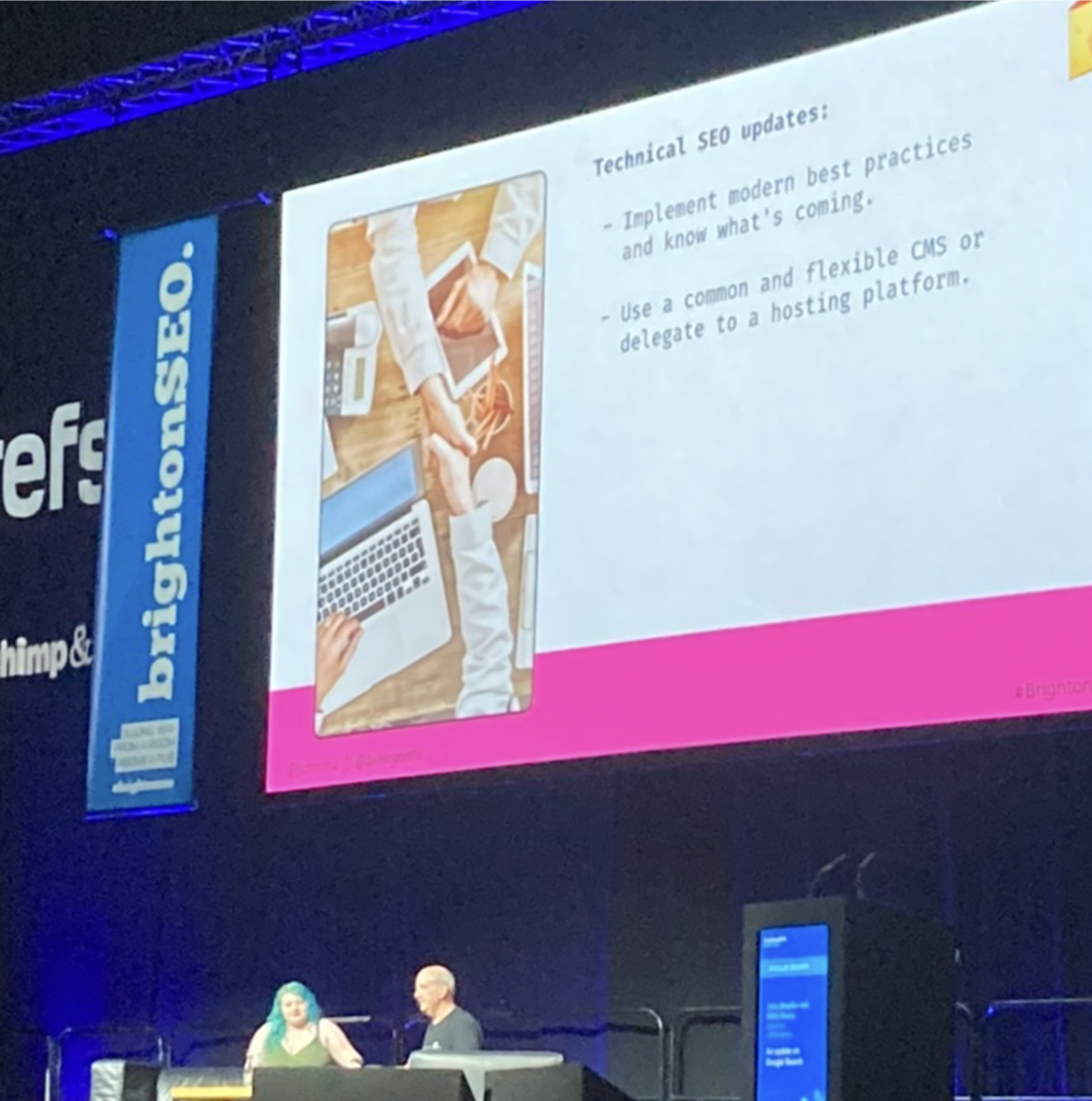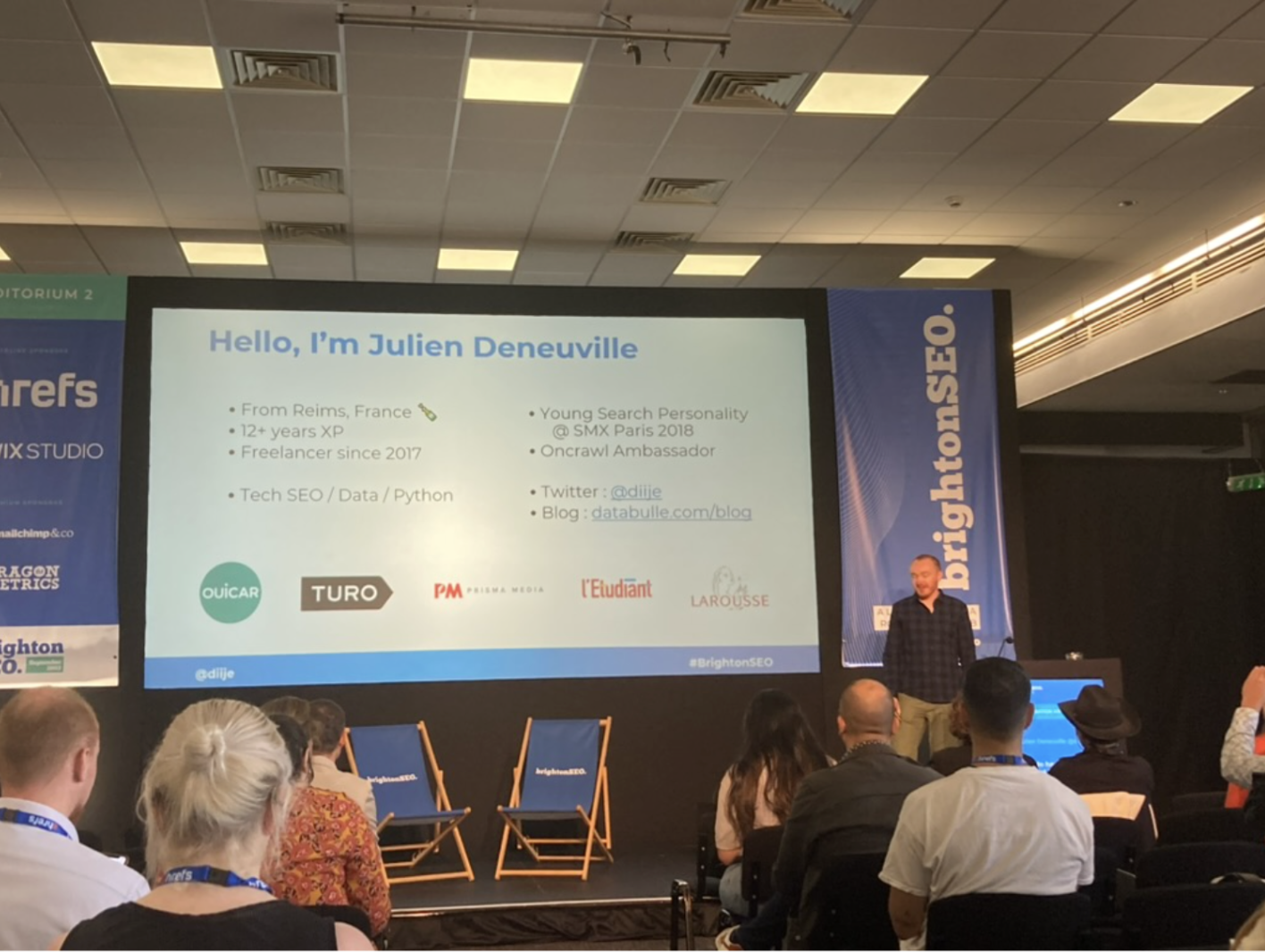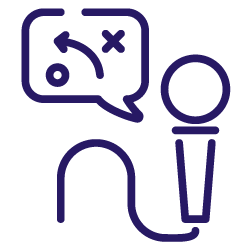When working in an industry that is constantly evolving, it’s always important to take a step away from the keyboard to meet with colleagues and peers, get a couple refreshers on best practices, and also keep up to date on the latest trends.
BrightonSEO is the place to do just that and for this edition, our team was able to attend a lot of the great talks and gather some thoughtful insights. Regardless of your specific job role, industry, or level of expertise, there was definitely something for everyone.
For this recap article, we’ve decided to do things a bit differently. Instead of just looking at some of the talks we found the most interesting, we thought you might be keen to read about the key takeaways by industry.
What can e-commerce SEO experts take away?
In recent years, the e-commerce industry has experienced undeniable growth and will likely continue to do so in the foreseeable future. How do we know that?
Well, as Greta Koivikko pointed out in her conference, ‘Ecommerce SEO tactics for luxury brands,’ Millennials and Gen Z prefer shopping online because of the convenience and ease of price comparison. As those aspects aren’t easily replicated in the in-person experience, it’s unlikely we’ll see a reverse in the trend.
E-commerce is now an inextricable part of the global retail landscape and to be able to successfully manage such a site in terms of its SEO, it’s important to understand your users and create the optimal user experience.
The e-commerce page experience should be seamless and in order to create that, both Sara Fernández Carmona and Vanda Pókecz spoke of the benefits of implementing the design thinking process. The user-centric approach consists of five phases (empathize, define, ideate, prototype and test) that help you better understand your users and address specific needs or problems.
Vanda shared a concrete example of the process in action and emphasized the fact that it’s important to have clear objectives and definitions established from the beginning of the process but that failings too can be used to learn.
Sara, on the other hand, dove deeper into the UX part of the process and pointed out that over 200 cognitive biases exist. We shouldn’t, however, fight them; we should “accept them and understand how they influence your life.” There are certain UX laws based on cognitive bias and getting familiar with them will help you apply them effectively in your design process.
Hick’s Law for example states that, “the time it takes to make a decision increases with the number and complexity of choices.” As an e-commerce site, too many choices, or too much cognitive load, can negatively impact your conversion rate.
Florian Elbers also addressed the same idea in his presentation, ‘Google’s messy middle and what (ecommerce) SEOs need to know about it’ when he discussed the paradox of choice. Ultimately, too much choice can overwhelm consumers and lead to them abandoning the process altogether. It’s important to find a balance in presenting the necessary information while also reducing the cognitive load.
So what does this all have to do with SEO? Sara summarizes nicely with the following quote:
“When users are satisfied, search engines are satisfied!” – Sara Fernandez Carmona, International SEO Consultant
Key takeaway: User experience should be one of your top priorities. Create a seamless experience that addresses your consumers’ needs but doesn’t heavily increase their cognitive load.
What can news and editorial SEO experts take away?
A few presentations addressed the subject of E-E-A-T during this edition of the conference. E-E-A-T is an acronym for Experience, Expertise, Authoritativeness, and Trustworthiness and since its introduction in 2014 (previously E-A-T), it has only grown in importance in regards to how Google and visitors perceive your website, particularly for YMYL sites.
Although not an official ranking factor, E-E-A-T is part of Google’s Search Quality Rater Guidelines that helps evaluators assess high-quality content.
News websites can fall into the YMYL (Your-Money-Your-Life) category because they share information that focuses on topics which could affect the wellbeing of people. A deeper understanding of E-E-A-T is crucial if you want to improve your news site’s SEO.
During the session, ‘Google Updates with John Mueller and Billie Geena,’ John Mueller emphasized that Google’s priority is delivering high-quality search results to its users, so you should focus on creating that quality content for your audience rather than for search engines.

The focus on quality content was a recurring theme that also popped up in Kathy Wong’s presentation:
“Content created by expert authors should be unique, in-depth and accurate.” – Kathy Wong, SEO Associate Account Director at Reprise Digital
And while it’s important to have expert content creators, Kathy explained that it is also imperative to know your audience.
According to Jess Maloney, Search Strategy Lead from Rise at Seven, if you want to understand more about your audiences’ interests, behaviors, and motivations, keyword research is a great way to discover those insights. Once you obtain that information, you can implement a content strategy that takes into consideration their search intent as well as rising trends.
Over the course of BrightonSEO, there was clear emphasis on the fact that good content is an essential building block of an effective SEO strategy, but when it comes to E-E-A-T, trustworthiness is equally necessary. E-E-A-T’s purpose is twofold; it not only helps Google provide credible, authoritative results in the SERPs, but it also helps internet users establish the trustworthiness of your site.
Kelly Johnstone, Head of Content at Staysure Group, shared a great presentation about ‘The biology of building trust’ in which she elaborates on how hard it is to build trust, but also offers examples of how it can be done through conversational intelligence.
Kelly explains that communicating ideas can get lost in translation from what you intend to say, to what you actually say, what is heard and what is ultimately understood. In order to build trust across your site, it helps to have the “boring trust markers”:
- Reputable authorship
- Reviews
- Testimonials
- Awards/security
In addition to these elements, trustworthiness can also have a lot to do with the professional design of your site. Kathy recommended taking measures to improve page speed, fix broken links and ensure that SSL certificates are installed.
Key takeaway: E-E-A-T continues to grow in importance. Remember to create quality content and build trust with your site visitors.
What can classified site SEO experts takeaway?
Websites with a lot of pages can often run into problems with thin or duplicate content, structural problems or poor internal linking. A few sessions at BrightonSEO focused on these recurring issues and some of the overall takeaways from the conference can be applied to classified and listing sites specifically.
It was inevitable that the subject of AI would be discussed this time around; it has, afterall, been in SEO news for months now. Aleyda Solis spoke on ‘Embracing AI in SEO: how to 10x your SEO leveraging AI bots.’
In her presentation she detailed how SEOs are changing the way they work thanks to AI. We shouldn’t really be wondering about whether AI will take over our jobs, because they can’t – human input will always be essential. Instead, Aleyda says that we should be thinking about how we can “leverage AI’s LLM tools or functionalities to support SEO tasks or efforts.”

For instance, we could be using AI to improve efficiency, speed up audits, and avoid manual errors. Or we could use it to “obtain cross-linking suggestions for a list of URLs based on their semantic relevance.” These were only two of the many suggestions Aleyda shared, but the overall ideas of improving efficiency and optimizing linking are important themes that were addressed in two other presentations.
Jack Roberts, Senior Technical Manager at Omio, described how to use AI for content creation. In his presentation, ‘Scale up: How to create unique content with open-source tools,’ Jack shared his strategy to reduce thin content using an open source solution to generate unique content in bulk. He also explained how to scale the process.

As Omio is an international and multimarket website with four verticals, their method had to be adaptable for each market and vertical variation. Their integration of AI helped them efficiently address a common problem found in the industry.
Another recurring problem that creeps up with large sites is inefficient internal linking strategies. Julien Deneuville’s presentation looked at ‘How to handle internal linking on large websites.’ As you likely know, crawl budget, or lack thereof, can affect large websites and internal linking is the key to optimizing how your site is crawled. But where should you start?

The first step is to fix your links by addressing the broken ones and avoiding redirects. Then, you should focus on analyzing what you already have in place as a linking strategy before determining your priority actions. Julien suggests:
- Splitting your inventory of pages (top, mid-tier, low-tier, garbage)
- Optimizing linking (down, up, transverse)
- Dedicating links slots by inventory split
- Measure and repeat
In wrapping up, Julien reminded us that we can only improve what we measure, so keep an eye on your crawl metrics and rankings to gauge your progress.
Key takeaway: For sites with a high volume of pages, SEO’s can achieve more by leveraging AI to improve efficiency in completing certain tasks. However, in-depth analysis still proves to be necessary when it comes to prioritizing your SEO actions.
Wrapping up
As always, the BrightonSEO conference was a great experience and all attendees definitely walked away with some food for thought.
We chose to focus on three specific industries for this recap, but don’t hesitate to let us know if you have any interesting thoughts or highlights to share regarding your specific role or area of expertise!

